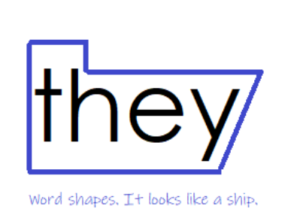Reading wars, Whole word VS. Phonics, whole language advocates vs. phonetics enthusiasts…
Who would imagine that learning to read could be such a controversial topic?
But sadly, it is!
And I use the word SADLY for a good reason: Because the ones that normally pay the consequences of this disagreement are our children!
In this article we will look at the differences between the whole word approach and the phonics approach, so you can learn the ins and outs of this hot debate and form your own opinion.
If your child is learning to read, this is a crucial topic for you to understand as a parent. The reading success of your child can depend very much upon the actual approach used to teach your child to read; and, as you will discover on this article, schools do not always use the most effective method.
When it comes to teaching children to read there are two main teaching methods.
These two main methods are the whole word approach (also called the “sight words” approach) and the phonetic or phonics approach.
Some prefer the whole word method, while others use the phonics approach.
There are also educators that use a mix of different approaches.
But, who is right?

The Whole Word Approach
The whole word approach relies on what are called “sight words”. This method basically consists of getting children to memorize lists of words and teaching them various strategies of figuring out the text from a series of clues. Using the whole word approach, English is being taught as an ideographic language, such as Chinese or Japanese.
One of the biggest arguments of whole word advocates is that teaching to read using phonics breaks up the words into letters and syllables which have no actual meaning. Yet they fail to acknowledge that once the child is able to decode the word, they will be able to actually read that entire word, pronounce it and understand its meaning. So, in practicality, this is a very weak argument, from our point of view.
Unlike Chinese, English is an alphabet-based language. This means the letters of the English alphabet are not ideograms (also called ideographs), like Chinese characters are.
An ideogram (or ideograph) is a graphic symbol that represents an idea or a concept. Simply put, ideograms are like logos.
So, in a way, you could say that in the Chinese language you need to teach children to memorize “logos” and the meaning of each of them.
It is not logic to think that English should be taught using an ideographic approach…
So, the very popular reading programs that use a whole word approach simply get children to memorize words using different strategies, but without teaching any proper decoding methodology.
Think of the example we used before of the logos and the Chinese language.
Besides, there is no scientific evidence to suggest that teaching your child to using the whole word approach is an effective method. However, there are large numbers of studies which have consistently stated that teaching children to read using phonics and phonemic awareness is a highly effective method.

The Whole-Word Approach in Schools…
So, is your child learning to read using sight words? Or maybe a mixture of phonetics and sight words? What is the standard approach in our education system?
Well, every country – and even every educator / school – is different.
However, in English speaking countries in general -with the exception of the UK, which has been encouraging schools to adopt a systematic synthetic phonics approach since 2011- reading instruction is normally more heavily weighted towards the teaching of sight words, emphasizing the learning of “word shapes”.
Despite all the evidence to suggest otherwise, the whole word method of teaching still dominates how reading is taught at schools.
Why? Well, our guess is that children can appear to make fast progress with the whole language approach, and that makes everybody happy…
That is until their progress stalls, which is what usually happens, because with this method many children do not learn the relationships between letters and sounds correctly.
Some children can finally understand the letter-sound relationships from the words they have learned, but unfortunately many children aren’t able to figure this out. So, they are left with only one strategy for learning to read: memory and continuous repetition.
This is a very poor strategy these children are left with, in our opinion.
On the other hand, the reading ability of children is normally exaggerated on whole word programs as the texts used are very repetitive and extremely predictable. The children know what to expect. So… They are basically guessing!
When children are presented with a less predictable text without pictures, they struggle with words they had previously been able to figure out in a repetitive text with illustrations.
Another strategy used in whole word programs consists of focusing on word shapes.
Just have a look at this image. This is a “reading strategy” used on whole word programs.

Encouraging children to learn to read by looking at word shapes is completely madness! They are told to look at words as if they were “pictures”, focusing on the overhangs in the shapes of words! This does not apply for the English language!! Again, this is a method used for ideographic languages, such us Chinese or Japanese.
It does not make sense! There are just so many words with very similar shapes!
For example, look at this:
- hat vs. bat

- tree vs. free
- fall vs. tall vs hall

- hunt vs. hurt vs. hard
And the list goes on and on and on… Honestly, we could find thousands of words that have similar shape if we had the time to do this exercise!

The Whole- Word Method and Spelling
Even if a child has some early success learning to read using whole words programs, it gets him/her into the habit of ignoring the letters in words. This causes serious reading problems later on (when texts get more complicated), including spelling problems.
Another strategy that we are told to do on whole word programs is encouraging our children to look at the pictures in storybooks to “guess” or “predict” words.
-
Can they use the picture to help?
-
Can they look at the initial letter and predict what word would make sense that starts with that letter?
-
What word makes sense based on the context?
A little bit of history on the Whole-Word Approach
The main idea behind this theory is that if you see words enough number of times, you eventually store them in your memory as visual images.
They also embrace the idea that kids can naturally learn to read if they are exposed a lot of books.
Since the 1980s, these beliefs had strongly influenced the way children in North America and most English speaking countries are taught to read and write.
These ideas start to emerge in the 1970’s, and they become extremely popular for teaching reading in the 80’s and 90’s.
There is a strong focus on meaning, rather than sounds.

The Phonics Approach
At the opposite end of the spectrum, we find reading instruction based on phonemic awareness and phonics.
The phonics approach focuses on the sounds in words, which are represented by the letters (or groups of letters) in the alphabet.
There is a myriad of methods and systems within the phonics approach itself, but the the two main methodologies for teaching phonics are Synthetic and Analytic phonics.
Even though they both have the label “Phonics” attached to them, they are in fact quite different ways for teaching children to read.
However, for the sake of this article (and to keep things simple) we will just say that the main difference is that in the Synthetic Phonics approach skills are taught in a highly structured ‘systematic’ way.
Children start with very simple sounds and decoding regular words. Gradually, they are introduced to more complex sounds (such us letter combination sounds) and to irregularities and exceptions. Every step of the way is planned, and children only move to the next stage of phonics once they have mastered the previous one.
In the Analytic Phonics approach, reading instruction is less structured, and learning happens in a more ‘embedded’ fashion. Children are encouraged to analyze groups of whole words to identify similar sounds and letter patterns. Instruction relies a lot on the analysis of “families of words”.
For instance, the family of words ending up in -all, such us “tall, fall, mall, hall, small”, or the family of words ending up in -at, such “mat, cat, rat, bat, fat, pat”.
If you are interested in knowing more about the differences between analytics and synthetic phonics, you can check this video.ç
<iframe width=”560″ height=”315″ src=”https://www.youtube.com/embed/twDjIsFkhFM” title=”YouTube video player” frameborder=”0″ allow=”accelerometer; autoplay; clipboard-write; encrypted-media; gyroscope; picture-in-picture” allowfullscreen></iframe>
Is there a Winner in the Reading Wars?
What Research / Modern Science has to say…
The best way to put an end to this controversy and start making decisions that are RIGHT for our kids – and not based on personal preferences or ideology- is by looking at what research and scientific studies have to say.
However, you may think that if opinions on the topic are still so divided, then it must be that the results of these studies are somehow inconclusive.
Well, not really…
Look at these statements by the US National Reading
“Teaching children to manipulate phonemes in words was highly effective under a variety of teaching conditions with a variety of learners across a range of grade and age levels and that teaching phonemic awareness to children significantly improves their reading more than instruction that lacks any attention to Phonemic Awareness.”
“Conventional wisdom has suggested that kindergarten students might not be ready for phonics instruction, this assumption was not supported by the data. The effects of systematic early phonics instruction were significant and substantial in kindergarten and the 1st grade, indicating that systematic phonics programs should be implemented at those age and grade levels.”
^* Report of the National Reading Panel. Teaching children to read: An evidence-based assessment of the scientific research literature on reading and its implications for reading instruction. Excerpts from the meta-analysis of over 1,900 scientific studies.
Overwhelmingly research has found that phonemic awareness and phonics is a superior way for teaching children to read!
But wait there is more…
Modern Scientific Research on the Brain and How we learn to read
For a very long time many experts have embraced the idea that we store words in our memory in the same way we store visual memories, such us faces or objects. That belief is at the core of the whole word approach.
And, in fact, many reading experts still believe this is the cse.
However, modern scientific research proves otherwise…
But before I tell you how we actually store words in our memory, look at the following factors already pointing out at how visual memory -contrary to still popular belief – is NOT involved:
-
We can read mixed case letters without difficulties.
-
We can read words with different fonts, in print and cursive, and handwritting without difficulties.
-
Word recognition works faster than object recognition, indicating that we are using different storage and retrieval processes.
Let me tell you about the sound scientific evidence now…
Brain scans show that the parts of the brain activated while performing visual memory tasks are different than the parts of the brain activated while reading…

Moreover, scientists in the visual memory area (not related to reading research, therefore unbiased) have indicated that we don’t have the cognitive capacity to remember 30 – 90,000 words for immediate retrieval.
As reading instruction still assumes that we store words as visual images, students who struggle to remember words are many times presumed to have poor visual memory.
This couldn’t be further from the truth. There is only a small relationship between visual memory and our capacity to store words for immediate retrieval while reading.
However, there is a very strong relationship between HEARING skills and our capacity to store words for immediate retrieval while reading (fluent reading capacity).
To be more specific, children that have been trained to hear the actual sounds that form words (phonemic /phonological skills) and are capable to recognize and store those common strings of sounds and visually link them to the letters / words they know become fluent readers.
There is no evidence to suggest that visual memory has a role in word recognition /reading fluency once the letters and the connection between letters and sounds have been learned.
If there seems to be a winner on the ‘Reading Wars’, why do we keep arguing?
Phonics instruction cons…
These are the main arguments against phonics instruction:
- Children only read phonics books: This is one of the main pillars of a proper phonics system. Children should only attempt to read books that are in line with their level of phonics. Otherwise, it is overwhelming for them and can get confused, since they may be exposed to too many exceptions and irregularities. While this is true, that doesn’t mean that parents can’t read more difficult books to their children. And, in fact, they are encouraged to do so.
- Phonics doesn’t help with reading comprehension. Besides, teaching to read using phonics breaks up the words into letters and syllables, which have no actual meaning. However, once the child is able to decode the word, he/she will be able to actually read that entire word, pronounce it and understand its meaning.
- Children learn to read naturally, therefore they don’t need tedious phonics instruction. Whereas it is truth that some children can learn to read by themselves, most won’t be able to figure it out. Besides, there is no harm in receiving phonics instruction for those that are able to learn to decode by themselves.
- There are just too many exceptions and irregularities in English. While it is true that English is full of irregularities and exceptions, there are less of these than what we are led to believe. Besides, there are some rules, patterns and tips and tricks that apply to those “irregular” words that certainly do help in the process of learning to read.
So, saying that phonics has won the war is quite far from what happens in reality.
As we stated at the beginning of the article, there are different ways for teaching phonics.
What our schools have evolved to do to keep both sides of the war happy is establishing a “balanced literacy” strategy that combines both whole word and phonics principles.
What in practicality ends up happening is that there is only a little bit of phonics instruction here and there, rather than a proper curriculum based on phonics.
That is an ineffective method for teaching phonics, and certainly doesn’t work. And this is precisely the sort of evidence that whole word enthusiasts hold on to.
Final thoughts on the Reading Wars
The debate is still hot. This is bizarre as, in our opinion, based on the latest scientific evidence, the number one skill that we need to develop in our children is phonemic awareness.
This way we would have far fewer students with reading difficulties.
And, after having developed strong phonological / phonemic awareness skills, using a proper phonics approach (and not just a little bit of phonics instruction here and there) seems like the way to go.
Free Resources you may be interested in!
Phonemic Awareness Activity Worksheets
Nursery Rhymes Ebook
44+ English sounds chart
List of CVC Words

Hey there! I’m Laura – an author, YouTuber, blogger, and the creator of the “Learning Reading Hub” platform. I created this space to dive into the world of reading instruction and to shout from the rooftops about how vital it is to use the right methods for teaching reading. I’ve got a TEYL certification (Teaching English to Young Learners), plus a Journalism degree from the University of Navarra in Spain, along with a Master’s Degree in Communication.
I’ve always loved digging into research, jotting down my thoughts, connecting with people, and sharing what makes me tick. With a background in marketing, digital projects, and the education scene (especially language learning), I’m all about wearing different hats.
When my first kid needed to learn how to read, it opened my eyes to the challenges and complexities involved. This journey took me through a rollercoaster of self-teaching, eye-opening discoveries, and yeah, some letdowns too. There’s so much conflicting info out there, along with methods that just don’t cut it. And let’s face it, these issues are way too common.
Now, I’m all about channeling that passion (without sounding like a know-it-all!) and sharing my journey. My mission? Making it easier for those who are on the same path I once was.
My heart’s with my family and the amazing Learning Reading Hub project. I live with my husband and two little ones, raising them in a bi-lingual environment (English and Spanish).


5 replies on “Whole Word vs Phonics – Reading Wars! – Understanding the Differences between these 2 Approaches”
[…] Whole Word vs. Phonics. All indicators are that phonics gives the best results when teaching kids how to read. Yet still […]
[…] Whole Word vs. Phonics. All indicators are that phonics gives the best results when teaching kids how to read. Yet still […]
[…] Whole Word vs. Phonics. All indicators are that phonics gives the best results when teaching kids how to read. Yet still […]
[…] Whole Word vs. Phonics. All indicators are that phonics gives the best results when teaching kids how to read. Yet still […]
[…] Whole Word vs. Phonics. All indicators are that phonics gives the best results when teaching kids how to read. Yet still […]